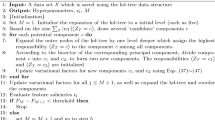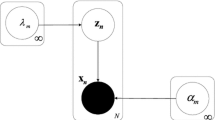Abstract
During the last few decades, many statistical approaches that were developed in the fields of computer vision and pattern recognition are based on mixture models. A mixture-based representation has a number of advantages: mixture models are generative, flexible, plus they can take prior information into account to improve the generalization capability. The mixture models that we consider in this paper are based on the Dirichlet and generalized Dirichlet distributions that have been widely used to represent proportional data. The novel aspect of this paper is to develop an entropy-based framework to learn these mixture models. Specifically, we propose a Bayesian framework for model learning by means of a sophisticated entropy-based variational Bayes technique. We present experimental results to show that the proposed method is effective in several applications namely person identity verification, 3D object recognition, text document clustering, and gene expression categorization.




Similar content being viewed by others
References
Alizadeh A, Eisen M, Davis R, et al (2000) Distinct types of diffuse large B-cell lymphoma identified by gene expression profiling. Nature 403:503–511
Ansary TF, Daoudi M, Vandeborre J (2007) A bayesian 3-d search engine using adaptive views clustering. IEEE Trans Multimedia 9(1):78–88
Attias H (1999) A variational Bayes framework for graphical models. In: Proceedings of neural information processing systems (NIPS), pp 209–215
Bahrampour S, Moshiri B, Salahshoor K (2011) Weighted and constrained possibilistic C-means clustering for online fault detection and isolation. Appl Intell 35(2):269–284
Ben-David S, Kushilevitz E, Mansour Y (1997) Online learning versus offline learning. Mach Learn 29 (1):45–63
Ben-Yacoub S, Abdeljaoued Y, Mayoraz E (1999) Fusion of face and speech data for person identity verification. IEEE Trans Neural Netw 10(5):1065–1074
Bhanu B, Lin Y (2003) Genetic algorithm based feature selection for target detection in SAR images. Image Vision Comput 21(7):591–608
Bimbo AD, Pala P (2006) Content-based retrieval of 3D models. ACM Trans Multimed Comput Commun Appl 2(1):20–43
Bishop CM (2006) Pattern recognition and machine learning. Springer, Berlin
Bouguila N (2008) Clustering of count data using generalized Dirichlet multinomial distributions. IEEE Trans Knowl Data Eng 20(4):462–474
Bouguila N, Ziou D (2006) A hybrid SEM algorithm for high-dimensional unsupervised learning using a finite generalized dirichlet mixture. IEEE Trans Image Process 15(9):2657–2668
Bouguila N, Ziou D, Vaillancourt J (2004) Unsupervised learning of a finite mixture model based on the Dirichlet distribution and its application. IEEE Trans Image Process 13(11):1533–1543
Boutemedjet S, Bouguila N, Ziou D (2009) A hybrid feature extraction selection approach for high-dimensional non-Gaussian data clustering. IEEE Trans Pattern Anal Mach Intell 31(8):1429–1443
Bronstein M, Kokkinos I (2010) Scale-invariant heat kernel signatures for non-rigid shape recognition. In: Proceedings of the 2010 IEEE conference on computer vision and pattern recognition (CVPR), pp 1704–1711
Bustos B, Keim DA, Saupe D, Schreck T, Vranić DV (2005) Feature-based similarity search in 3D object databases. ACM Comput Surv 37(4):345–387
Cardinaux F, Sanderson C, Bengio S (2006) User authentication via adapted statistical models of face images. IEEE Trans Signal Process 54(1):361–373
Collins RT, Liu Y (2003) On-line selection of discriminative tracking features. In: 9th IEEE international conference on computer vision (ICCV 2003), 14–17 October 2003, Nice, France, pp 346–352
Constantinopoulos C, Likas A (2007) Unsupervised learning of Gaussian mixtures based on variational component splitting. IEEE Trans Neural Netw 18(3):745–755
Corduneanu A, Bishop CM (2001) Variational Bayesian model selection for mixture distributions. In: Proceedings of the 8th international conference on artificial intelligence and statistics (AISTAT), pp 27–34
Daras P, Axenopoulos A (2010) A 3D shape retrieval framework supporting multimodal queries. Int J Comput Vis 89(2-3):229–247
Faivishevsky L, Goldberger J (2009) ICA Based on a smooth estimation of the differential entropy. In: Koller D, Schuurmans D, Bengio Y, Bottou L (eds) Advances in neural information processing systems 21, pp 433–440
Fan W, Bouguila N (2014) Online variational learning of generalized Dirichlet mixture models with feature selection. Neurocomputing 126:166–179
Fan W, Bouguila N, Ziou D (2011) A variational statistical framework for object detection. In: 18th international conference on neural information processing, ICONIP 2011, pp 276–283
Fan W, Bouguila N, Ziou D (2012) Variational learning for finite dirichlet mixture models and applications. IEEE Transactions on Neural Networks and Learning Systems 23(5):762–774
Fan W, Bouguila N, Ziou D (2014) Variational learning of finite Dirichlet mixture models using component splitting. Neurocomputing 129:3–16
Froba B, Ernst A (2004) Face detection with the modified census transform, pp 91–96
Gao Y, Wang M, Zha Z, Tian Q, Dai Q, Zhang N (2011) Less is more: efficient 3-d object retrieval with query view selection. IEEE Trans Multimedia 13(5):1007–1018
Gao Y, Wang M, Tao D, Ji R, Dai Q (2012) 3-D object retrieval and recognition with hypergraph analysis. IEEE Trans Image Process 21(9):4290–4303
Geusebroek JM, Burghouts GJ, Smeulders AWM (2005) The amsterdam library of object images. Int J Comput Vision 61(1):103–112
McLachlan GJ, Peel D (2000) Finite mixture models. Wiley, New York
Haering N, da Vitoria Lobo N (1999) Features and classification methods to locate deciduous trees in images. Comput Vis Image Underst 75(1):133–149
Haigh J, Mason JS (1993) A voice activity detector based on cepstral analysis. In: Proceedings of the European conference on speech communication and technology, pp 1103–1106
Hensman J, Rattray M, Lawrence ND (2015) Fast nonparametric clustering of structured time-series. IEEE Trans Pattern Anal Mach Intell 37(2):383–393
Jain A, Ross A, Prabhakar S (2004) An introduction to biometric recognition. IEEE Trans Circuits Syst Video Technol 14(1):4–20
Ji Y, Wu C, Liu P, Wang J, Coombes KR (2005) Applications of Beta-mixture models in bioinformatics. Bioinformatics 21(9):2118–2122
Jordan MI, Ghahramani Z, Jaakkola TS, Saul LK (1999) An introduction to variational methods for graphical models. Mach Learn 37(2):183–233
Kaya M, Alhajj R (2008) Online mining of fuzzy multidimensional weighted association rules. Appl Intell 29(1):13–34
Kim H, Howland P, Park H (2005) Dimension reduction in text classification with support vector machines. J Mach Learn Res 6:37–53
Kim S, Kweon I (2008) Scalable representation for 3D object recognition using feature sharing and view clustering. Pattern Recogn 41(2):754–773
Kittler J, Hatef M, Duin R, Matas J (1998) On combining classifiers. IEEE Trans Pattern Anal Mach Intell 20(3):226–239
Langley P, Provan GM, Smyth P (1997) Learning with probabilistic representations. Mach Learn 29 (2-3):91–101
Leonenko N, Pronzato L, Savani V (2008) A class of rényi information estimators for multidimensional densities. Ann Stat 26(5):2153–2182
Lewis D D, Yang Y, Rose T G, Li F (2004) RCV1: A new benchmark collection for text categorization research. J Mach Learn Res 5:361–397
Li X, Guskov I (2007) 3D object recognition from range images using pyramid matching. In: IEEE 11th international conference on computer vision, (ICCV 2007), pp 1–6
Liang F, Liu C, Wang N (2007) A robust sequential bayesian method for identification of differentially expressed genes. Stat Sin 17:571–597
Martino L, Read J, Luengo D (2015) Independent doubly adaptive rejection metropolis sampling within gibbs sampling. IEEE Trans Signal Process 63(12):3123–3138
Masoud H, Jalili S, Hasheminejad SMH (2013) Dynamic clustering using combinatorial particle swarm optimization. Appl Intell 38(3):289–314
McLachlan GJ, Khan N (2004) On a resampling approach for tests on the number of clusters with mixture model-based clustering of tissue samples. J Multivar Anal 90(1):90–105
Nasios N, Bors AG (2006) Variational learning for Gaussian mixture models. IEEE Trans Syst Man Cybern B Cybern 36(4):849–862
Nian R, Ji G, Zhao W, Feng C (2007) Probabilistic 3D object recognition from 2d invariant view sequence based on similarity. Neurocomputing 70(4-6):785–793
Penalver A, Escolano F (2012) Entropy-based incremental variational Bayes learning of Gaussian mixtures. IEEE Transactions on Neural Networks and Learning Systems 23(3):534–540
Poh N, Kittler J, Alkoot F (2012) A discriminative parametric approach to video-based score-level fusion for biometric authentication. In: Proceedings of the 21st international conference on pattern recognition (ICPR), pp 2335–2338
Reynolds D (1994) Experimental evaluation of features for robust speaker identification. IEEE Transactions on Speech and Audio Processing 2(4):639–643
Reynolds DA, Quatieri TF, Dunn RB (2000) Speaker verification using adapted gaussian mixture models. Digital Signal Process 10(1–3):19–41
Robert C, Casella G (1999) Monte carlo statistical methods. Springer, Berlin
Rotella F, Leuzzi F, Ferilli S (2015) Learning and exploiting concept networks with conNeKTion. Appl Intell 42(1):87–111
Sanderson C, Lovell B (2009) Multi-region probabilistic histograms for robust and scalable identity inference. In: Tistarelli M, Nixon M (eds) Advances in biometrics, lecture notes in computer science, vol 5558, pp 199–208
Sanderson C, Paliwal KK (2003) Fast features for face authentication under illumination direction changes. Pattern Recogn Lett 24(14):2409–2419
Sanderson C, Paliwal KK (2004) Identity verification using speech and face information. Digital Signal Process 14(5):449–480
Shih J, Lee C, Wang JT (2007) A new 3D model retrieval approach based on the elevation descriptor. Pattern Recogn 40(1):283–295
Shilane P, Min P, Kazhdan M, Funkhouser T (2004) The princeton shape benchmark. In: Proceedings of the shape modeling international 2004, SMI ’04, pp 167–178
Soong F, Rosenberg A (1988) On the use of instantaneous and transitional spectral information in speaker recognition. IEEE Trans Acoust Speech Signal Process 36(6):871–879
Sun J, Ovsjanikov M, Guibas L (2009) A concise and provably informative multi-scale signature based on heat diffusion. In: Proceedings of the symposium on geometry processing, SGP ’09, pp 1383–1392
Vien NA, Ertel W, Dang VH, Chung T (2013) Monte-carlo tree search for Bayesian reinforcement learning. Appl Intell 39(2):345–353
Wildermoth BR, Paliwal KK (2000) Use of voicing and pitch information for speaker recognition. In: Proceedings of the 8th Australian international conference on speech science and technology, pp 324–328
Yuan ZH, Lu T (2013) Incremental 3D reconstruction using Bayesian learning. Appl Intell 39(4):761–771
Acknowledgments
This research was partially funded by the National Natural Science Foundation of China (61502183, 61673186), the Scientific Research Funds of Huaqiao University (600005-Z15Y0016), and the Natural Sciences and Engineering Research Council of Canada (NSERC). The second author is funded by a NSTIP KACST grant (13-INF1123-10),
Author information
Authors and Affiliations
Corresponding author
Rights and permissions
About this article
Cite this article
Fan, W., Al-Osaimi, F.R., Bouguila, N. et al. Proportional data modeling via entropy-based variational bayes learning of mixture models. Appl Intell 47, 473–487 (2017). https://doi.org/10.1007/s10489-017-0909-0
Published:
Issue Date:
DOI: https://doi.org/10.1007/s10489-017-0909-0




